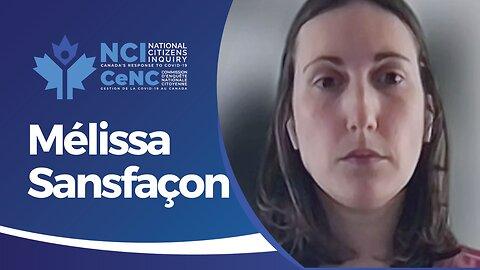Mélissa Sansfaçon témoigne en tant que témoin civil à la Commission d’enquête Nationale Citoyenne. Mélissa, employée de bureau dans une compagnie d’électricité, partage son expérience personnelle de souffrance due à une sensibilité et une douleur extrêmes du côté droit de son corps à la suite du vaccin contre la COVID-19. Elle offre un récit convaincant de la manière dont cette blessure causée par le vaccin a affecté sa vie quotidienne et les défis auxquels elle fait face dans le système de santé. Son témoignage met en lumière l’impact réel des blessures liées aux vaccins sur les individus et leurs familles. Accordez votre attention pour entendre son histoire.
* The above video is being streamed via Odysee. Check back often as we continue to update the complete list of links to all witness testimonies in both video and audio/podcast formats.
[00:00:00]
Louis Olivier Fontaine
So good morning, everyone. Let me introduce myself: my name is Louis Olivier Fontaine. I am a lawyer and today I am acting as a prosecutor for the National Citizens Inquiry. Hello, Madame Sansfaçon. Can you hear me well?
Mélissa Sansfaçon
Yes
Louis Olivier Fontaine
So, Madame Sansfaçon, I’m going to start by identifying you. I would ask you to state, please, your first and last name.
Mélissa Sansfaçon
Mélissa Sansfaçon.
Louis Olivier Fontaine
All right. And another formality to start: I’m going to ask you to take an oath. Do you solemnly affirm to speak the truth, the whole truth and nothing but the truth? Say: I affirm.
Mélissa Sansfaçon
I affirm.
Louis Olivier Fontaine
So today, Madame Sansfaçon, you have been invited by the National Citizens Inquiry to testify about the consequences you suffered as a result of the COVID injections. On behalf of the Commission, I would like to thank you for your availability and your courage to testify today. To begin I would ask you, just briefly, to tell us what your occupation is, Madame Sansfaçon.
Mélissa Sansfaçon
I am an information management consultant. But I can name my employer. I work for Hydro-Quebec. So it’s basically office work with meetings and things like that.
Louis Olivier Fontaine
All right. As has been said, you received the COVID injections and suffered consequences. I would like to know what are the reasons that led you to receive these injections.
Mélissa Sansfaçon
Mainly, I went because, since his birth-basically, the first two years of his life-my son has been hospitalized twice each winter. So we suspected that it was to continue. We were a little afraid that if, say, he was to catch COVID, he would have to be hospitalized too. And at that time, you had to be vaccinated to accompany someone to the emergency room. So the main reason I went was that. It’s that I didn’t want to leave my two-year-old child alone in the emergency room. And at my work, there was talk about making it, let’s say, strongly suggested. But the main cause is really my son.
Louis Olivier Fontaine
All right. In fact, I would like to know; before having received the COVID injections, what was your state of health, in general, without going into details. But what was your state of health?
Mélissa Sansfaçon
Still good. I just had irritable bowel, basically, since the 2000s, but otherwise I was mostly healthy.
Louis Olivier Fontaine
All right. So we are now going to talk about the first injection you received. Could you tell us what state of mind you were in before receiving the first injection, and what happened during and after that first injection?
Mélissa Sansfaçon
I definitely went there in a somewhat resigned state of mind because I didn’t feel I needed to have the vaccine. I saw it a bit like the flu vaccine. If you are more likely to get sick if you catch the flu, you would take the flu shot. I saw it somewhat the same with COVID. But, you know, at the same time, it gave me a certain peace of mind because I thought to myself, “If my guy ever has to be hospitalized, at least I can go with him.” Once the injection happened, in fact during my 15-minute wait, I started having symptoms. Basically, at that time, at the site of the first dose, it was the feeling of a heavy and swollen arm that started during my 15-minute wait and which lasted for four days following that.
Louis Olivier Fontaine
Do you remember the approximate date?
Mélissa Sansfaçon
Yes, it was May 23, 2021.
Louis Olivier Fontaine
Perfect. Do you remember the brand of product you received?
Mélissa Sansfaçon
Pfizer.
Louis Olivier Fontaine
Okay. So I understand that you felt some effects. What happened next?
Mélissa Sansfaçon
I’m not sure I understand your question. After what?
Louis Olivier Fontaine
Yes, so I believe that, in reading your file, we saw that you also received a second injection.
[00:05:00]
Mélissa Sansfaçon
Yes. Yes, I got my second injection on July 25, 2021. Then when I got there the nurse asked me what side effects I had on my first dose- Excuse me, I’m just going to drink some water. I explained to her, basically, what I just told you, that I had had the sensation of a heavy and swollen arm for four days. To which she replied: “Well, expect worse, because people really react more strongly to the second dose.” So once I had my injection and was in my 15-minute wait, my arm started to feel numb. So I just said to myself: “Well, well, this time, it’s not the heavy and swollen arm, it’s going to be numbness.” Then I left after the 15-minute wait.
Louis Olivier Fontaine
All right. Regarding that, could you talk about the symptoms you had or the consequences you had following that second injection? What steps you took in relation to your health?
Mélissa Sansfaçon
Briefly, because I really had a lot. Basically, we can say that I still have numbness present in my right arm today. I have it in my right leg too. In fact, it’s at different intensities. Sometimes it goes as far as needle sensations that are painful, both in my arm and in my leg. Sometimes the numbness goes up along the neck, in the face, the lips. Sometimes on the left side, but that’s rarer. It’s really more concentrated in the right arm and leg. We can also add to that all the burning sensations. The way I explain it best is that it’s like having a full body sunburn. When you have a sunburn, you don’t realize that you are in pain; we scratch and then it becomes painful. It’s rather the same principle here, but I have it from the roots of my hair to the soles of my feet. The burning sensations-I’m sorry, but my meds are making my mouth dry-have basically resulted in a hypersensitivity of most of my right side. Hypersensitivity to heat first; it developed this winter in response to the cold as well. Humidity, fabrics, heat, so admittedly the skin, the water, the shower-all these are things that I have to manage-that’s the term I have, but that’s not quite it. Basically, I now shower in lukewarm water, things like that. The heat: as soon as the sun touches me, it is the same feeling as with a sunburn, as I was saying earlier. So as soon as the sun touches me, I react strongly: it’s as if it were burning me right now. The direct consequences following the injection are these: the numbness, the needle sensations, and the hypersensitivity with the burning sensations.
Louis Olivier Fontaine
All right. And did you receive any formal diagnoses during your dealings with healthcare personnel? What diagnoses have you received, if any?
Mélissa Sansfaçon
I have not yet. I went through countless tests, if you count my three visits to the emergency room in a month and a half. In fact, the first time I went to the emergency room after my second injection was for ten days. They gave me countless blood tests. I had a brain scan, electrocardiogram, head to spine MRI. I also had an-I want to say this correctly-EMG, the test for the central nervous system. And lately, I’ve had two skin biopsies. I had a first biopsy in mid-October which turned out to be voided, if I may say so, in the sense that the skin specimen was poorly preserved. So I had to do another one, this time at the end of January, for which I am still officially awaiting the results from my neurologist-we have an appointment at the end of the month-but which seems to indicate the same result as the first, according to what is in my Quebec Health file. So my skin specimen would have been poorly preserved again this time, and theoretically, I will have to do a third one.
[00:10:00]
I don’t know if I can take two minutes to explain because the reason I’m discouraged is that the first biopsy aggravated my symptoms enormously. Excuse me . . .
Louis Olivier Fontaine
Take your time, no problem.
Mélissa Sansfaçon
It’s a very incapacitating disability, if I may say so, in the sense that I’m constantly looking for ways to improve my daily life. Hypersensitivity means I can’t cuddle my own daughter anymore because she’s too hot. Her skin is too hot. I can’t hug my spouse either for the same reason. Even with a layer of clothing, I have to be careful because it ends up burning me. You can imagine how “comfortable” it is to sleep or even just sitting up surrounded by pillows.
But the biggest impact is really regarding the clothing because clothing burns me. There are clothes that are okay one day and not okay the next day. I’ve completely reoutfitted my wardrobe twice. And each time something gets worse, I have to redo the whole process. I’m on the verge of doing it all over again for a third time. And it’s always that I have to think two steps ahead. I will give an example: earlier I mentioned the sun, the heat, with temperatures like those today. Last year I had to teach my daughter-she was seven years old at the time-to take the car key, put the car on “accessory mode” to open the windows because I can’t get into the car to lower them myself, because it’s as if I’m putting my whole self into an oven. It’s super painful. Always having to think about different ways to try to go about my daily life is what exhausts me.
And the biopsy happened between the death of a person I considered to be as a grandfather and the death of my grandmother. Both happened very suddenly, and then the biopsy added physical stress to the emotional stress I was experiencing at the time. From the moment of the biopsy, my body overreacted because that’s how hypersensitive it is-it overreacted. I couldn’t lean on the side of my leg, in fact where the biopsy is, where they took the piece of skin. This is exactly where my sock elastic touches. So I absolutely had to fold my sock, fold my winter boot. Then, I constantly had to keep a plaster on it to prevent any fabric, whether my leggings or whatever, from falling on it. And that went on even up to the week I had to go for my second biopsy.
For the second biopsy, my body reacted less strongly than the first time, but there was an additional layer of symptoms that was added on top. Even today, although the two wounds have healed, it feels as if they were raw. I can’t touch them. I can’t lean on them. Just sitting cross-legged is impossible for me. I have to always fold my sock. And the other example that I can give you is that my feet-I’m a girl, I have lots of kinds of shoes-my feet, at present, only tolerate one pair of shoes: my Converse. Even though the back of the Converse sits below where my wound is, when I drive, I feel like it’s pushing right on the wound, even though there’s still a lot of space before you get to the wound site. So it’s the fact of having constant pain, which is very mentally tiring. But it’s also having to constantly think of solutions to be able to live my daily life, which should be super simple, but adds an additional level of effort.
[00:15:00]
Not knowing what it is, that it has almost been two years-I have a hard time accepting that I may be stuck with it for life.
Louis Olivier Fontaine
Tell me, Madame Sansfaçon, how did you perceive the reaction of the healthcare personnel during all the steps you took to identify the cause of your symptoms?
Mélissa Sansfaçon
I consider myself lucky because I’ve spoken with other people who have had side effects who were told it was all in their heads. Except the first time I went to the ER; the ER doctor looked at me really hard and then said, “No, no, that’s okay. It’s only been ten days. It’s normal, go home. It will disappear.” Then despite me asking him, “Okay, let’s say it doesn’t go away, what should I do?” “No, no, no, it will go away. Good day.” But the last two times I went to the ER, people believed me. They made me take tests. They saw that there was something wrong, even though I had no obvious physical traces.
After that, when I went to the emergency room, I was referred to neurology. The neurologist also ordered tests. It doesn’t matter what they do because I’ve seen so many people. Right now, I’m being followed by a psychologist in chronic pain management, and also by an occupational therapist for managing chronic pain. I’m going to start physio soon. I am followed for medical cannabis, neurology, I saw a dermatologist, all that. And while I don’t want to point fingers, generally what they tell me is that maybe it was something that I had that was dormant, which the vaccine would have triggered. Others tell me: “No, no, no, it really is the vaccine. We see the cause because your symptoms started during your 15-minute wait. So, it’s hard not to make the connection with the vaccine.”
But these people who say “yes, it really is the vaccine” are rare. More of them want to say that it is something dormant that I had awakened, for whatever reason. But these are symptoms I’ve never had. It’s hard to say, “Okay, maybe, yeah, something was dormant in my system.” But one way or the other, whether it’s something dormant or not, well, the trigger is still the vaccine. So, in my opinion, I see the link. It’s there. It started in my 15-minute wait. They aren’t symptoms that I had before, so it’s the vaccine.
Louis Olivier Fontaine
And how do you present the situation when you approach these healthcare personnel? Do you have a way of approaching them, presenting your symptoms? For example, do you suggest that link? How do you present your situation to healthcare personnel?
Mélissa Sansfaçon
I never hid anything. I’ve always said it started in my 15-minute waiting period. And that it has only gotten worse. Basically, the three times I went to the emergency room at the beginning-I went to the emergency room three times within a month and a half-I always told them that it was in relation to the vaccine. I always told them it kept getting worse. And by then it was getting worse every two weeks. Every two weeks, I had a new symptom that popped up, which appeared intermittently and then took hold permanently.
Now, almost two years later, the development is, let’s say, slower, in the sense that it’s not every two weeks that I have a new symptom, it’s maybe every month, month-and-a-half. It’s just that it’s added to an already overwhelming situation. So it always seems a bit like the end of the world when a new symptom sets in, because no one really knows what it is. Nobody is able to really put it into words. What I’m being told is that, with a disease like mine, it’s difficult to have a sure and precise diagnosis in the sense that they go by process of elimination.
[00:20:00]
Okay, I understand. Currently, I have two probable diagnoses: sensitive Small Fibre Neuropathy, which is, in essence, a malfunction of the nervous system of the skin. That’s a first diagnosis that should, one day, if a valid biopsy comes back, be confirmed by that. And I would have to take another test to confirm another diagnosis, which would be Reflex Sympathetic Dystrophy. Then we add to that something I learned recently, which is allodynia, which is basically, from what I understand, a feeling that’s not supposed to be painful and that becomes painful. The same idea as, you know, having my sweater feel like it currently burns me, but it is not supposed to burn me. A kind of, as I was saying earlier, hypersensitivity of the skin, things like that.
But the delays are extremely long. You know, being told twice that my skin specimen was poorly preserved, when each time it [the biopsy process] made my symptoms worse, then being told, “You really should-we need this-you really should have it done a third time.” Let’s say, I don’t really feel like it.
Louis Olivier Fontaine
And perhaps, in a few words, what were the consequences for you at the professional level?
Mélissa Sansfaçon
Actually, the first time I went to the emergency room, the first time I was examined, it was my office colleagues who pushed me to do so. We were, well, for sure we were in a pandemic; we were working from home. The arm in which I got vaccinated is my arm, what do you call it, the main arm in any case, my right arm, my dominant side, in short. The reason why I chose this arm, again, comes down to my son; I still needed to be able to hold him since he was young. I have always held my children with my left arm. So what I wanted was that if ever there was some pain in my arm at the injection site, well, I would still be able to hold my son.
The reason why my colleagues pushed me to get checked out is that they saw me using the computer mouse on the right at the level of the screen. Then they said to me, “Hey, Melissa, what’s going on?” I then said to them: “Well, I don’t know. My arm is more numb than usual. It’s not pleasant, so I’m using my left hand.” I didn’t make a big deal of it, in that I told myself that it’s going to end eventually and then it’s going to be okay. Then they said to me: “No, no, no, you are going to see a doctor.” So I went for an examination. And after the third time I went to the emergency room, I saw my family doctor, who acted, basically, as an orchestra conductor. She was somewhat the coordinator: “Okay, we should try returning to the emergency room, have fewer delays, see a neurologist,” things like that. But when it came to all the medical paperwork, all that, she was the central core. Then, in the weekend that followed my last visit to the emergency room and the appointment I had with her, I had the burning sensations begin to appear. And when I told her about it, she said, “Okay, I think we’re going to put you on sick leave for two or three weeks while you see the neurologist; we find out the results of the tests you’ve just taken; we see what’s going on, all that, then after that, we’ll reevaluate.”
Finally, after much paperwork, the doctor reevaluated me and gave me an indeterminate leave of absence. So I’ve been off work for over a year and a half, mainly because my burning sensations are so much stronger on the right side.
[00:25:00]
So the whole outer side down to the fingers, with which I use the keyboard, mouse, all that: it’s the side that hurts me the most. And I also have trouble remaining in the same position for long. Whether it’s standing or sitting. If I sit too long, my right leg becomes extremely numb. If I stand too long, my biopsy wounds begin to, I just have the term in English, “throb.” In any case, in short, they hurt. Which means that I often joke a bit by saying that I adopt the stance of a pink flamingo: I have to lift on one leg because it hurts too much. So for all these reasons, the work stoppage remains indefinite, at least until we find a medication that helps me in my daily life. Then again, it’s a been a failure so far because I’ve tried six drugs, and I haven’t yet found one that works for me.
Louis Olivier Fontaine
Madame Sansfaçon, I can see that you are wearing something on your right forearm. Could you say a few words about that?
Mélissa Sansfaçon
Yes, basically, since the holiday season, my hypersensitivity symptoms have gotten so bad that I constantly have to have my right forearm bandaged, which is where my hypersensitivity is most acute. It’s not tight, it’s really just to make a kind of sleeve. Besides, if it is too tight, it increases the numbness. So that’s a good indicator. It’s really just to create a sort of crutch against the elements because a sweater that may be okay one day, as I was saying earlier, may not be okay another day. But it’s the same between my two arms. It can be fine on the left, but not fine on the right because on the right side I’m always overreacting. So putting this on allows me to-I don’t like the term-be more efficient in trying to get through my daily life. Because, as I was saying earlier, if, let’s say, we break a foot, we’re going to use crutches to be able to keep walking. Well, for me, this is my crutch. It’s putting a bandage on my forearm and my hand to be able to go about my business.
It’s a bit the same principle as, you know, on my desk, I have a homemade “ice pack” because ice is the only thing that allows me to reduce the burning sensations. So I constantly have ice packs that I had to make at home-I know it’s not good, but with food transport ice packs because those from the pharmacy didn’t stay cold long enough for me. I really needed something that could last me more than an hour. Not that I need it constantly. It’s just that when my hand gets too hot, at least just being able to lean on the ice helps me keep going.
Louis Olivier Fontaine
So we are now coming to the end of your testimony, Madame Sansfaçon. The Commission suggested that we ask a question: how things could have been done to make things better for you. I understand that your case is extremely difficult and you have very serious symptoms, but is there anything, ultimately, that could be done or could have been done to make you better?
Mélissa Sansfaçon
In relation to vaccination or in relation to what I am currently experiencing?
Louis Olivier Fontaine
In general, whether it’s regarding vaccination or it’s just in general.
Mélissa Sansfaçon
You know, even though the term “compulsory” was never used, we can agree that the rights of the non-vaccinated were so violated that we did not really have a choice. As I said earlier, I’m not hiding anything. The main reason I went was for my son. Because I wanted to be present with him if ever he had to have something done, or if he had to be hospitalized. If it hadn’t been compulsory-because here, it was basically compulsory to accompany someone to the hospital-I would have followed the other measures: to stay two meters away from everyone, to wear a mask, it doesn’t matter, the Purell [hand sanitizer], whatever. I would have followed all the measures. I wouldn’t have been vaccinated. And of course, I think about it.
[00:30:00]
Of course, I say to myself, “Why did I go? Why did I do this?” But, again, it’s always about my son.
But what really exhausts me is the fact that medical personnel, in general, do not want to make the connection with the vaccine in the first place. As I said earlier, I never hid the fact that, for me, it was connected to the vaccine. They always try to sideline me by saying, “well, maybe that, maybe this, maybe that.” No, no, no, it started in my 15-minute waiting period. I’ve never had symptoms like this before, so in my mind, the connection is clear. But it doesn’t seem like medical personnel want to recognize this, no matter the specialization or whatever. That’s something I also hear from people I’ve spoken with who have side effects that are different from mine. We’re not really supported because we feel misunderstood, in the sense that since people don’t want to make the connection to the vaccine, it’s kind of like, in a way, saying it’s a bit in our heads. But that’s false. It’s completely physical, even if I have no obvious physical signs.
I talk about it a lot. When I talk about my case, I always say that it’s as if they don’t consider it urgent because I’m not bleeding out. But my quality of life suffers enormously and increasingly, whether it’s just time passing or, as I was saying earlier, the biopsies that have made my condition worse. And regardless, the delays are always endless. I understand that we are lacking people in the health sector. I understand that there are many people who are sick. I don’t want to jump ahead in the queue for anything. It’s just that I really feel that because I have no physical traces, because I’m not bleeding out, it’s not seen as urgent, whereas I see it as urgent.
Maybe it’s silly, my daughter compares me to a vampire. Honestly, that’s pretty much it. I can’t go outside without being in pain. I must be in the shade. If we go to the park with my children, I have to hide under the play structures. Of course the other parents look at me and think I’m weird. Except those who know me, they know why. But, you know, the other parents at the park, they wonder why the lady, she practically runs under the play structure. It’s mentally exhausting, it’s physically exhausting. But just minimally-because we certainly can’t change anything; we’ve had the injection; look, what’s done is done, we look ahead-to be recognized, to be told: “Yes, it’s okay, I know it’s the vaccine. Do not worry. We will take the appropriate steps accordingly because we know that’s it.” Just that, it’s worth all the gold in the world. But it is difficult.
Louis Olivier Fontaine
Okay, thank you very much for your testimony, Madame Sansfaçon. Now, maybe the commissioners will have some questions for you. So I will now give the floor to the commissioners if they have any questions.
Commissioner Massie
Do you understand English or do you need me to translate the question?
Mélissa Sansfaçon
No, no, I understand English.
Commissioner Massie
All right.
Commissioner DiGregorio
Thank you for your testimony. Excuse me, I will ask my question in English, but if you can answer in French- Has your injury been reported to a vaccine adverse injury reporting system such as CAEFISS [Canadian Adverse Events Following Immunization Surveillance System] in Quebec or in Canada?
Mélissa Sansfaçon
It’s a good question. I know I have a doctor who has-
Commissioner Massie
I’m going to have to translate the question into French first for the audience here. So my colleague’s question is whether your vaccine injury was properly reported to the health authorities.
Mélissa Sansfaçon
I have a doctor who has reported to the public health level. We are talking about January last year here, so January 2022. This was the first person who spoke to me about that. I didn’t even know there was a system to report this to public health. Yet I’ve seen many people between July and December.
[00:35:00]
So she took the steps for the report to, in short, reach the level of public health in Quebec. And the public health nurses followed me for one year from the date of vaccination. That’s what they do, they told me. But my file remains open at the level of public health in Quebec, since it is not settled, and it continues to get worse. So I no longer have occasional follow-ups, as I did for the first year following vaccination. But if I need information or have things to add to my file, I have a phone number that I call and there is someone who calls me back, who speaks with me in fact. Also, this same doctor is taking steps to fill out the Quebec form for the victim compensation program. But we haven’t finished yet because we wanted the results of the biopsy, which we don’t have. So I’m not sure when it’s going to be ready.
Commissioner DiGregorio
Thank you.
Louis Olivier Fontaine
So that would be complete for the commissioners’ questions. So, it only remains for me to thank you, Madame Sansfaçon, for having testified today before the National Citizens Inquiry. Allow me to congratulate you on your courage and availability. So thank you and have a nice day.
Mélissa Sansfaçon
Thanks, you too.
[00:37:07]
Final Review and Approval: Erin Thiessen, October 27, 2023.
The evidence offered in this transcript is a true and faithful record of witness testimony given during the National Citizens Inquiry (NCI) hearings. The transcript was prepared by members of a team of volunteers using an “intelligent verbatim” transcription method, and further translated from the original French.
For further information on the transcription process, method, and team, see the NCI website: https://nationalcitizensinquiry.ca/about-these-translations/
Summary
Mélissa Sansfaçon témoigne en tant que témoin civil à la Commission d’enquête Nationale Citoyenne. Mélissa, employée de bureau dans une compagnie d’électricité, partage son expérience personnelle de souffrance due à une sensibilité et une douleur extrêmes du côté droit de son corps à la suite du vaccin contre la COVID-19. Elle offre un récit convaincant de la manière dont cette blessure causée par le vaccin a affecté sa vie quotidienne et les défis auxquels elle fait face dans le système de santé. Son témoignage met en lumière l’impact réel des blessures liées aux vaccins sur les individus et leurs familles. Accordez votre attention pour entendre son histoire.






















